Thursday, November 8, 2012 hours 17:30
Presentation of the book: “Il Bagaglio del Marinaio”
 Esmeralda Remotti in association with the Superintendence for Archaeological Finds of Tuscany Esmeralda Remotti in association with the Superintendence for Archaeological Finds of Tuscany
Thursday November, 8 from 5:30 p.m. to 6:30 p.m. - Sala Bianchi
The publication of the data relating to the wooden box found in the excavations of Pisa - San Rossore and its contents, provided an opportunity to inaugurate the series "Ship Museum", with which we intend to publish the complete edition of the contents related to the Ships of Pisa, as well as giving space to all those texts that will cover the areas of study and interest of the Museo delle Navi Romane of Pisa.
The series promises therefore to edit, as systematically as possible, the huge amount of stratigraphy, material culture and historical data that a particular site such as the San Rossore one was able to give us in nearly fourteen years of excavations and research.
The case of the excavation of the " bagaglio del marinaio " is emblematic to represent how, from very micro analytical information concerning one object of the daily life, you could get such large considerations on the lifestyle and culture of those who lived about 1700 years ago. Excavation in this context also contributed, as a small piece in a much larger mosaic, to provide important information for the general interpretation of the deposit of Pisa and for the study of the river trade of the Imperial period.
The reading of the archaeological record has made it possible to reconstruct with great precision a part of the way crossed by the river Auser in the first half of the third century. At this point the cargo ship called "Ship A " sank, reclining on the south shore, within the which were located the " bagaglio del marinaio." This finding is of great importance for the general interpretation of the entire deposit of Pisa and, in particular, of the north-east area of the site, where in a small space a little more than two feet thickness of the deposit, went to tangle vessels A, D and I, for one chronological development from the third to the seventh century AD.
The possibility of dating with great precision, thanks to the materials of the load but, above all, thanks to the coins that were found inside the wooden box, the sinking of the ship A, has set a benchmark in the chronological complex stratigraphic sequence.
So the wooden box is primarily a closed context, still in situ, within a scheme extremely fluid such as that which saw the formation of many river banks, and the arrival of many massive floods that have shaped and reshaped the landscape of Pisa in over many centuries. But, as will be seen in the contributions included in this volume, this artefat means also many other things.
First of all it opens a view on the ancient technology, allowing us to explore the development of the techniques of carpentry, and on how these ones have evolved in the Imperial age and how much, however, have borrowed from the refined experiences gained in the same field in the Hellenistic period. The choice of wooden species with which the box was produced confirms the great ability of the Roman world to draw on a wide variety of species not necessarily local and at the same time, the style of the artefact describes the ancient traditions to whose the forms produced in the third century were still inspired, even with details such as the two-colour surface, that have little to do with functionality and a lot to do with the evolution of fashion and taste.
The objects stored inside the box are also extremely rich in ideas.
It is very likely therefore that the baggage could belong to one of the ratings assigned to the vessel or to a passenger of not high rank, occasionally hosted on the ship. However, in addition to being a focal point for the analysis of this scientific and historical context, this first volume of the series Ship Museum wants to build a new, and hopefully fruitful way to share with the public, not only necessarily specialized, all the archaeological data and documents that a discovery of this type represents.
This need, as argued in a series of speeches proposed in the book, was born from the desire to use innovative and very functional forms of documentation in the analysis of data and in the design of the interventions. Such technologies, as will become clear browsing this volume, accompanied all the stages of the research: from excavation, restoration, functional and historical analysis, to the realization of an exhibition accompanied by educational tools both virtual and materials.
The basic step that we want to do with this publication is to provide the same analytical tools, in both simplified forms that are fully functional, not only to authors, but also the users of the work, hoping to be a trend of quality in terms of archaeological documentation creating a better communication among different scholars and, more generally, among all those who are interested in this kind of researches.
Speakers: Isabella Lapi, Andrea Pessina, Andrea Cavilli
web site |